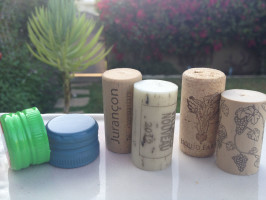The everyday conversation on corks vs. screw caps sounds something like this:
“Wines with a twist-off cap cannot be as good as wines with a cork,” or “Screw cap wine is cheap,” or “It’s just more sophisticated/traditional/fun/ceremonial to open a bottle with a corkscrew.”
 My studies for the WSET Diploma have begun and the wine geek in me finds the discussion of brett, malolactic fermentation, lees stirring, and reverse osmosis just fascinating. The average wine consumer need not concern themselves with such matters, but a true and deep understanding of wine production – from vineyard to glass – requires a working knowledge of such concepts.
My studies for the WSET Diploma have begun and the wine geek in me finds the discussion of brett, malolactic fermentation, lees stirring, and reverse osmosis just fascinating. The average wine consumer need not concern themselves with such matters, but a true and deep understanding of wine production – from vineyard to glass – requires a working knowledge of such concepts.
A topic that’s popping up (pun intended! ) a lot, which is and should be of interest to the wine consumer, is wine closures – those things used to stop the bottle. There’s much talk, research, and debate about natural cork vs. synthetic cork vs. aluminum screw cap vs. other options.
The everyday conversation on corks vs. screw caps sounds something like this: “Wines with a twist-off cap cannot be as good as wines with a cork,” or “Screw cap wine is cheap,” or “It’s just more sophisticated/traditional/fun/ceremonial to open a bottle with a corkscrew.”
The first two topics are debatable and much researched, but I agree with the last point … most of the time. There is a nice vibe to the ritual of uncorking a bottle of wine, hearing that “plop” sound, and then extracting the cork from the corkscrew and testing it with a quick sniff. The ritual of uncorking a lovely bottle of wine – not to mention the plethora of cool corkscrews now available [I have a large collection] – cannot be replicated with a twist-off cap.
However, if wine flows as freely in your household as it does in mine the convenience of the twist-off cap is often welcome. I don’t need the uncorking ritual for every bottle I open. I just want that wine pouring into my glass … quickly.
But what about the wine quality issue. Are corks better for wine than twist-off caps and is synthetic cork inferior to real cork? Does it really matter?
Generally speaking, corks are used for premium wines that are meant to age, in some cases 20 years or longer. They have thus far proven to be the best option, although screw cap research is ongoing and may prove this wrong. But for the world’s top wine producers cork is the closure of choice, and it’s been used for centuries in “old world” wineries. But overproduction of cork, with less-than-perfect production techniques, led to the issue of “cork taint.” Corks are also expensive to produce. These factors all combined sometime in the 1960s to lead to the development of alternative closures for wine.
Cork taint makes a wine smell unpleasantly musty or moldy. If a just-opened bottle smells of cardboard, the wine likely has cork taint. The taint is brought on by the presence of a substance called trichloroanisole, or TCA. Cork manufacturers have been developing methods for treating corks to reduce TCA contamination, as well as making improvements in the processes that lead to TCA contamination in the first place. In fact, a Code of Good Manufacturing Practice for Cork was developed in the early 1990s by the European Cork Federation. [It should be noted that TCA can also be introduced into the wine from barrels and other winery equipment –cork is not always the culprit.]
Corks can also allow a slow seepage of oxygen into the bottle, and oxygen can be both a friend and a foe in winemaking. Too much oxygen leads to oxidation, a flaw in wine. For example, when a cork dries out and loses its natural elasticity, it becomes ineffective as a seal and oxidation can prematurely age the wine. Oxidized wine has lost its fresh, fruity aromas and becomes flat smelling. Worst case scenario, the oxygen converts the wine’s natural (and desirable) acid into acetic acid, which is basically vinegar. On the flip side of this – and this is what is being intensely studied by the experts – a little oxygen can be good for the long ageing process, allowing the wine to develop complex flavors and aromas over time.
Synthetic corks are intended for use on wines that are drunk within a year of bottling. And these days, that’s many wines, as the trend is to produce wines for consumption while young. Synthetic corks are not suitable for wines aging longer periods because they do not provide sufficient protection from oxygen, and some synthetics can also harm the flavor of the wine over time. But they come in many pretty colors, and that’s appealing on a marketing level.
Aluminum screw caps have become fashionable, with both producers of high- and low-end wines. How can you not love a product that provides an impermeable seal from air – hence no oxidation – has been shown to preserve the fruit flavor in wine longer than cork, is less expensive than cork, and offers wine with one quick twist of the wrist? Screw caps are becoming increasingly popular for red, white, and rose wines where the fresh fruit character is important to the winemaker. But some winemakers are worried that the total oxygen seal, which does not allow the small amount of oxygen seen to occur with natural corks, will not allow for the proper development of some wines.
The industry continues its long-term studies on corks, synthetics, and aluminum screw caps, as well as on cork-synthetic hybrids, glass toppers (expensive), a thing called Zork (a plastic device with a tear strip that does not require a corkscrew), and other closures. Only time will tell what the results will be, and there are lovers and haters on all sides of the discussion.
Until next time, uncork or unscrew and Cheers!
Theresa Nozick
(t) @tnozick





 Hi I’m Catherine, founder of Wine Women And Chocolate. Want to become a contributor for Wine, Women & Chocolate? Interested in sharing your unique perspective to a group of supportive, like-minded women?
Hi I’m Catherine, founder of Wine Women And Chocolate. Want to become a contributor for Wine, Women & Chocolate? Interested in sharing your unique perspective to a group of supportive, like-minded women?
Hi Terry –
I hope you’re doing well. I came across your recent wine closures post on Wine, Women and Chocolate and thought I’d quickly drop you a note and introduce myself.
My name is Whitney Rigsbee and I work for Nomacorc, the world’s largest producer of synthetic wine corks. We produce nearly 2.4 billion closures a year and offer a range of closures that are suited for both quick-turn wines (like you mentioned in your post) as well as those meant for aging. *Note, we’re not those horrible plastic plugs that break your corkscrew or cause premature oxidation.
The darker color synthetic that you included in your photo is actually one of the closures I was referring to that is suitable for aging. It is part of our Select Series (http://www.nomacorc.com/wine-closure-select-series.php) and they are offer predictable oxygen ingress so that winemakers can precisely control the development of the wine after it is been bottled.
There are actually many premium wineries that now use our Select Series due its oxygen management benefits. Feel free to take a look at some of our customers: http://www.nomacorc.com/flip-award-winning-wine/award-winning-wine.html
If you’d like to discuss further any more about Nomacorc or wine closures in general, just let me know. Best of luck to your WSET Diploma studies too! We’ve had some Diploma and MW students visit our facilities as part of their coursework for the exam. Let me know if you’re even interested in coming out to our HQ in North Carolina.
Cheers,
Whitney
Whitney, thanks for the great comments. I will share the information with my Diploma classmates … good to know. And thanks for reading the column on Wine, Women & Chocolate.